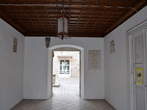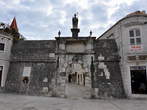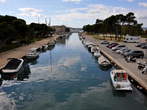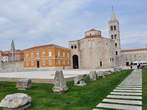Trogir is a picturesque town and port in Croatia, which belongs to the Split-Dalmatia County. It is located about 30 km from Split, in the Trogir Channel, at the end of the Kastela Bay. It lies on a small island between the mainland and the island of Ciovo.
It is separated from the mainland by a narrow channel with moorings for boats, over which two bridges lead, one for pedestrians and the other for road traffic. The third bridge on the north coast connects the center of Trogir with the part of the city on the island of Ciovo and with the shipyard. Since 1997, the historic center has been included in the UNESCO World Heritage List due to its urban-architectural design dating back to antiquity, well-preserved Romanesque-Gothic architecture and Venetian-style buildings. The largest cultural and historical monuments include the city center with around ten churches and many palaces and houses from the 13th century, the city gate from the 17th century, the cathedral of St. Lovrenc from the 13th century, the princely palace from the 13th century, the Kamerlengo Fortress from the 15th century, the large and small Cipiko palace from the 15th century and the city lodge from the 15th century. In the area of the current city, in the 3rd century BC, Greek colonists from the island of Vis founded the settlement of Tragurion, which developed into an important port. With the development of the city of Solina, which is today a suburb of Split, Trogir began to lose its importance.
After the collapse of the Roman Empire, the settlement came under the rule of Byzantium. In the 9th century, Trogir became the seat of a diocese, which was abolished in 1828. The Republic of Venice recognized the independence of the inhabitants in 1000, and since then Trogir began to trade with the Italian peninsula. Many cultural influences and initiatives for economic progress and improvement then came from there. The settlement received city rights in 1107. They were granted by the Hungarian-Croatian King Koloman. Saracen pirates almost destroyed Trogir in 1123. In 1420, the four-hundred-year period of power of the Republic of Venice began, during which the city was led by a leader confirmed in Venice with his city administration. Around 1650, a manuscript of the Satirikon by the ancient Roman writer Petronius was discovered in Trogir. In 1918, Trogir came under the authority of the Habsburg Monarchy. In the period before the Second World War, it was an integral part of the SHS and then the Kingdom of Yugoslavia. After the Second World War, Trogir was part of Yugoslavia until its dissolution and the declaration of the independent state of Croatia in 1991.
Today, Trogir is a lively tourist town that attracts many domestic and foreign visitors. In addition to the sights, the place is full of bars, pastry shops, and restaurants that invite you to sit down and admire the cultural beauty.







 HR-CRO - Croatia
HR-CRO - Croatia


















































